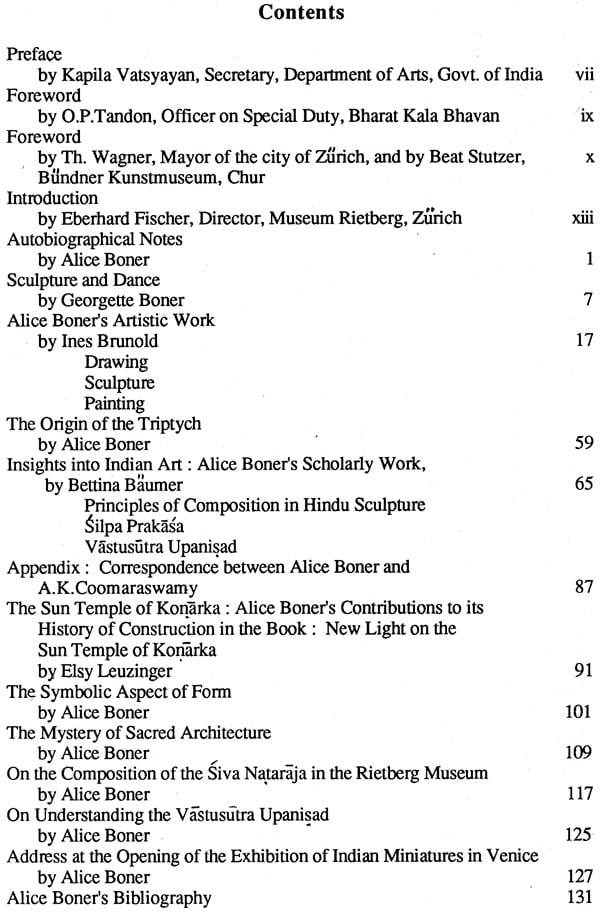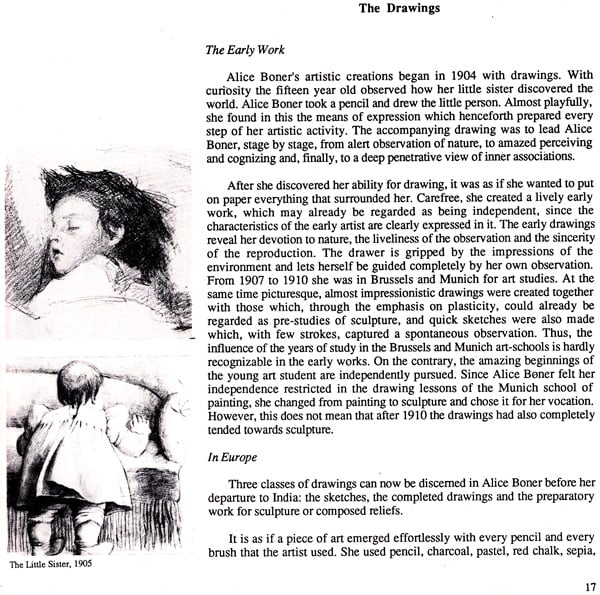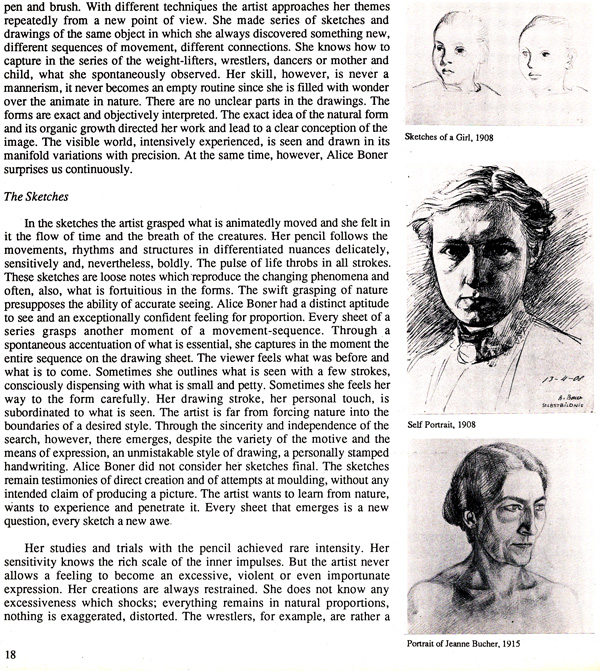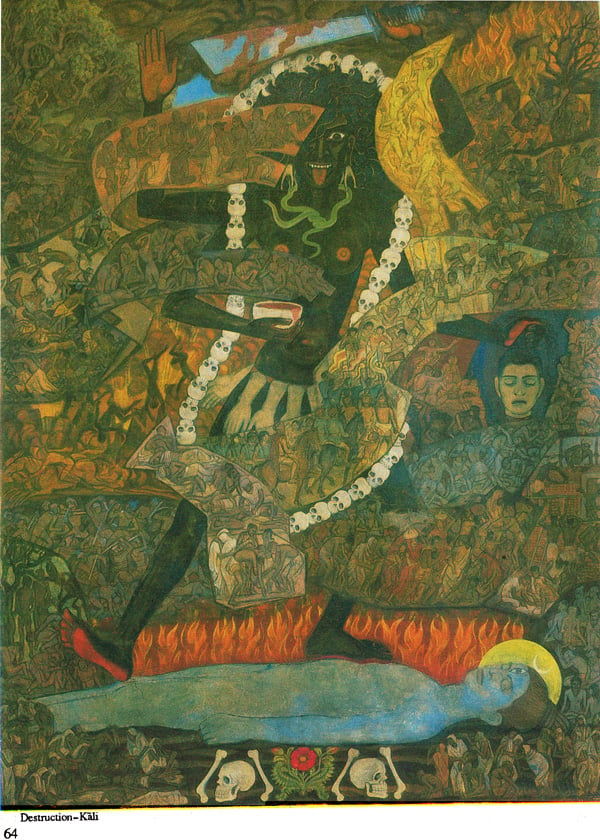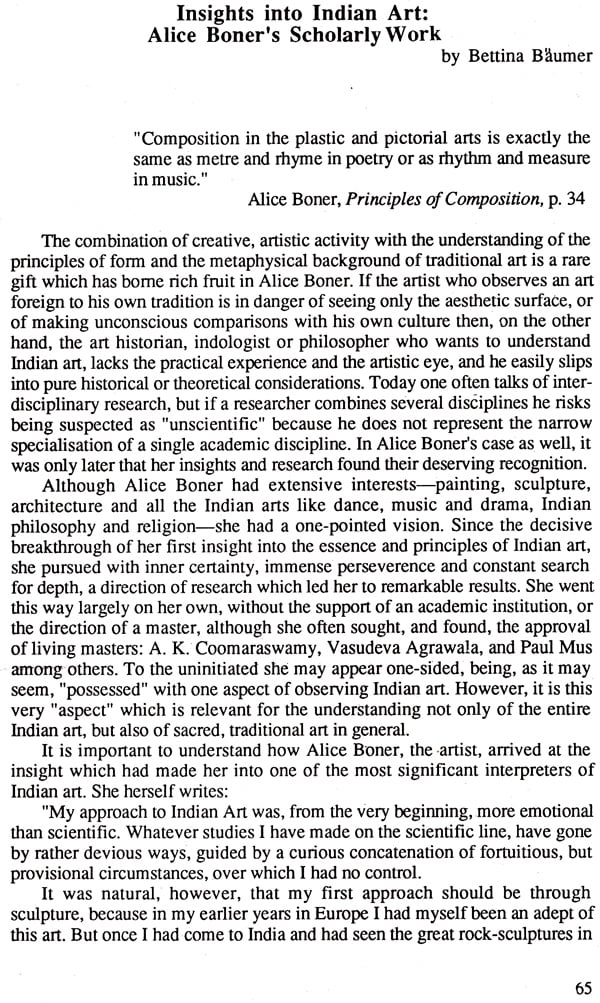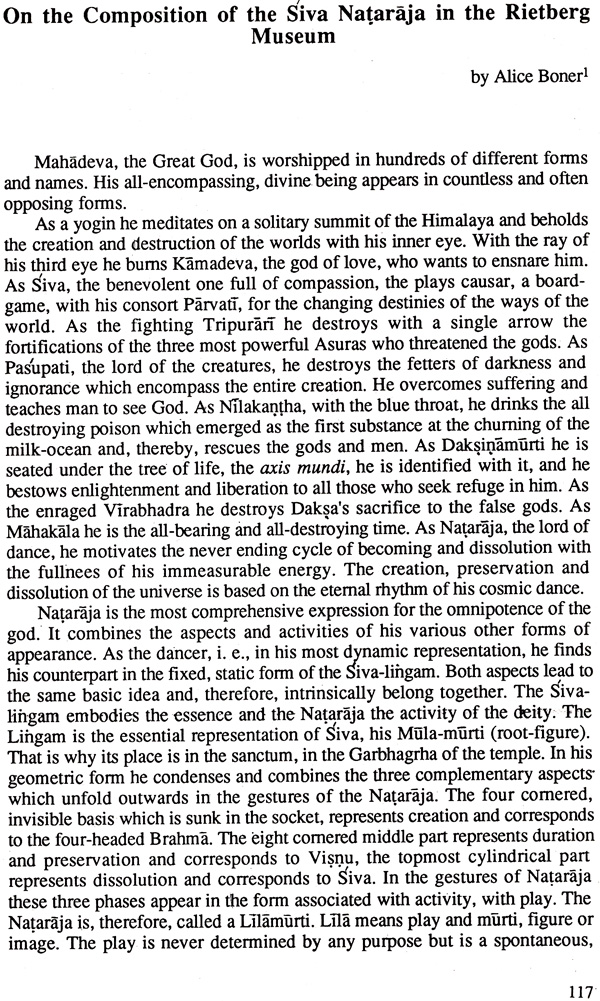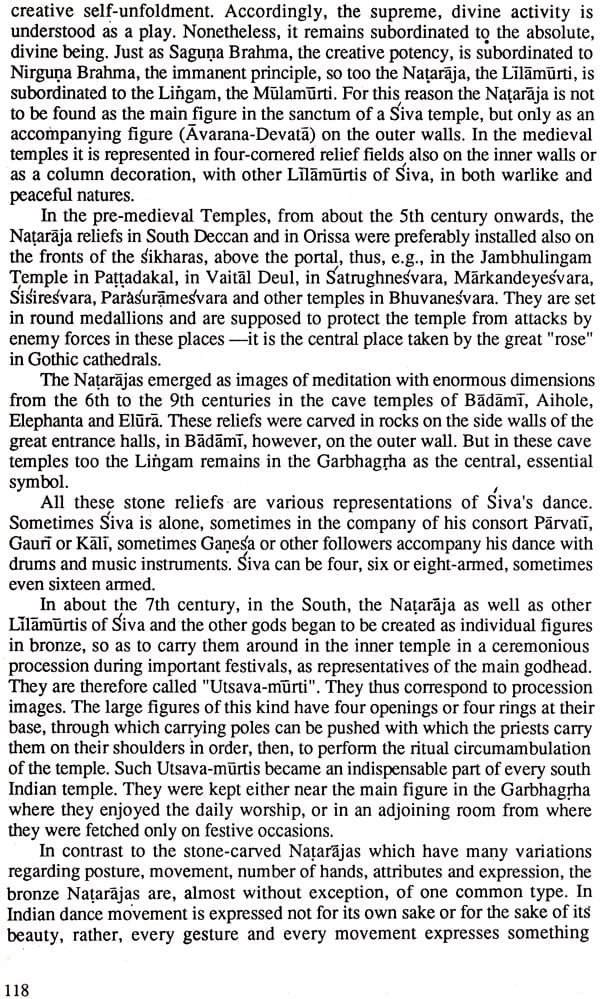
Alice Boner - Artist and Scholar (An Old and Rare Book)
Book Specification
| Item Code: | NAR484 |
| Author: | Alice Boner |
| Publisher: | Bharat Kala Bhavan, Varanasi |
| Language: | English |
| Edition: | 1982 |
| Pages: | 152 (Throught Color and B/W Illustrations) |
| Cover: | HARDCOVER |
| Other Details | 9.00 X 8.50 inch |
| Weight | 640 gm |
Book Description
Alice Boner, sculptor, painter, indologist, art historian and above all a quiet reflector of the inner self was unique as an individual and towering as a creative artist and critical scholar.
Her journey from the first decades of this century in Ziirich as a remarkable, sensitive and dynamic sculptress to the painter of those large canvasses emerging from the revelations of the experience of the Kali in India, give a glimpse of the transformation which took place in the artist and the 'self'.
As one looks back at her early work, especially in the reliefs called 'Adagio and Allegro', the very first thing that strikes one is her ability to capture movement, her figures are in a state of animated dynamic action traversing space and yet from within dynamic movement arises a steady stillness. Along with the juxtaposition of dynamic movement and stillness was her ability to experience and capture tenderness as in the sketches and sculptures of the series of 'Mother and Child': these provide a clue to the flame which guided these journeys. From the very start, there is a combination of an austerity, a discipline as in the portraits of 1907, 1908, 1915 and the easy flow of the brush in the sketches of 1926, 1927. All these expressed in a European context get transformed so easily without loss of an European identity into the remarkable sketches of 1938, 1940, 1941 executed in India. While she both anticipates and matches the quality of handling volumes of masses of Henry Moore in her sculptures, the paintings and sketches of the 40s approximate the quality of the charcoal sketches of Nandalal Bose and Abanindranath Tagore. She becomes, through her art, the bridge maker and a communicator, like her contemporaries in different spheres, namely, A.K.Coomaraswamy and Stella Kramrisch. In the thirties what they did through writing, Alice Boner achieved through painting and through that remarkable gift of being -designer of costumes of Uday Shankar. Had she not combined the skills and training of sculpture and painting and internalised the experience of Ellora and Ajanta, she could not have created the designs for costume and headgear for those compositions of Uday Shankar, today considered as classic. The deigning of the costume of a Nataraja has come to stay in all forms of contemporary dance. As patron, organiser, Director of the ensemble, she played a seminal role in the rejuvenation and recreation of both the neoclassical forms as also what we today recognise as modern dance.
But Alice Boner's journey was to continue at deeper levels and dimensions of consciousness, with as much ease and lack of self-consciousness. She settled in Banaras to watch the Ganga, to reflect upon its eternal flow, from the. Assi Ghat. One of the first expressions of this experience is the painting entitled Sun Rise from the Ganges (1945). No longer executed in a mode which could be confined to a stylistic school, she transcends boundaries. The centre and the radials of the Sun Rise on the Ganges are symbolic of the search of the creator. It is this inner transformation which gives her the energy to create the remarkable oils of the Stirya, Vigvariipa, Prakriti and Kafir in which the primeval energies radiate once again from the core of her authentic experience.
She took physical journeys between Assi Ghat and Ziirich at frequent intervals. These journeys were not only at the physical level. They represented the inner core of Alice Boner's whole personality. She did not give up her European identity and yet it was this European identity which was being constantly refined and chiselled at a subtler plane through an experience of India at the deepest plane.
Many have been puzzled by her unflinching commitment to Orissa, Konarka and the great oceans. But was this journey not also natural, because it followed the journey of the Ganga to the sea. And in this journey she found manuscripts, Shastric material at an intellectual plane which confirmed her intuitive insights into the fundamental tenets of the architecture, sculpture and painting of the land which she had chosen to make her home.
It is only befitting that her collections as also her creative work should be housed in the Rietberg Museum, Ziirich and the Bharat Kala Bhavan, Banaras. The two Museums holding the manifestations of this journey and search, I hope, will create through future scholarship, basis of a dialogue and a truly cross-cultural transboundary communication of the creative 'self.
Before Alice Boner passed away in April 1981, several Indian, European and American scholars were preparing a Felicitation Volume for her, containing articles and research reports, which was to appear in India, but which, sadly, had to be published as a commemoration volume. This volume evinces Alice Boner's significance for the history of art in India today. It was therefore appropriate to exhibit Alice Boner's work to a wider circle also in her hometown of Zurich and also in Chur where her family was registered. This publication together with the exhibition "Alice Boner and the Art of India" planned by the Rietberg Museum, Zurich, and shown in the Villa SchOnberg (in Autumn 1982) and in the Kunstmuseum in Chur (in Spring 1983), fulfilled this task.
It is a matter of great satisfaction that the Bharat Kala Bhavan in Banaras is showing Alice Boner's work as an artist as well as a scholar and collector of Indian art in a permanent Gallery. This is most befitting because she lived and worked in Banaras from 1936 to 1978 and had made it her home.
Alice Boner was a versatile, impressive personality. She was above all an artist-first a sculptor and then a painter-and she was an art critic who could recognize the significant in the great works of past times and foreign cultures, in the sculptures of Indian rock temples and also in the classical Indian dance which was despised and decaying at the beginning of our century, and she could explain, analyse and convey these intuitive experiences. Alice Boner lived a long life, was industrious, strong-willed, intensive, sometimes suffered privations but was nonetheless successful and highly respected. She was born at the close of the 19th century, and already in 1916 she presented her sculptures in an exclusive exhibition in the Kunsthaus, ZUrich; in 1930 she worked together with Uday Shankar for the revitalization of Indian dance; in 1936 she settled in Banaras in order to devote her life to Indian art and to religio-philosophical experience; and then she worked on three monumental books with Pandit Sadasiva Rath Sarma from Puri. The last great work Vastusiitra Upanisad had to be published posthumously, edited by her co-worker and successor Dr. Bettina Baumer.
This volume, intended as a supplement to the exhibition, shows the individual areas of work by Alice Boner: her life is sketched by herself, and also by an article by Dr. Georgette Boner on the significance of dance for Alice Boner. The artistic Oeuvre (drawings, sculpture and above all her oil paintings done in India) is, as a whole, honoured here for the first time by Ms Ines Brunold of Chur with illustrations, a few passages from her diary and by an introductory text. Alice Boner's aesthetic insights are presented in important articles, addresses or forewords to her monographs, some unpublished and some of which until now have been published only in German or Italian; these are supplemented by the reviews of her comprehensive and pioneering books on Indian aesthetics by Dr. Bettina Bhmer of Banaras and Professor Dr. Elsy Leuzinger, Zurich.
The editors of this book acknowledge with gratitude the numerous friends of Alice and Georgette Boner for their cooperation, without which it would have been impossible for the book to appear with such thoroughness. For the exhibition Dr. Ambros Boner drew the diagrams according to the "Principles of Composition".
The arrangement and production of the exhibition and the book were done in Ziirich through the Alice Boner Foundation for Fundamental Research in Indian Art and through the Rietberg Museum and we thank especially: Mr. Fridolin Miillervon Ins for designing the poster and book cover; the photographers Ms. Isabelle Wettstein and Ms. Brigitte Kammerer for the artistic advice on questions concerning layout and exhibition display. But neither the exhibition nor the book would have been realized without the extraordinary engagement of Dr. Georgette Boner, who immersed herself with all her strength in her sister's work and legacy, and who let her own work slip completely into the backgound-at least for the time being.
When I commenced with my work in the Rietberg Museum in 1972 the name "Alice Boner" was familiar to me only through her book "Principles of Composition". But soon I saw that as a collector and donor she had also made invaluable contributions to the Rietberg Museum. Besides the works of art donated by Baron Eduard von der Heydt the Museum had not been presented with such important sculptures from South Asia. There are works from North India, out of stone and terracotta, especially of the post Gupta period, of which some possess evident beauty and expressive power and some others are of iconographic rarity or of religiohistorical significance. I therefore felt the need to visit this scholar with her exquisite instinct for what is remarkable. On my very next trip to India after assuming office in Ztirich for documentation on Jainism, I made a detour to Banaras and met Alice Boner there for the first time. Later, I was her guest several times in her old residence at Assi Sangam. Alice Boner engaged herself here in her work for most of her long life, strong willed, with cool judgement and with a keen power of observation.
Today Assi Sangam is rented by the Alice Boner Foundation for Fundamental Research in Indian Art and the successor chosen and appointed by Alice Boner, the indologist Dr. Bettina B iumer, lives there in the same manner. I continue feeling happy in this place of thorough research which penetrates the essence of classical Indian art.
**Contents and Sample Pages**
